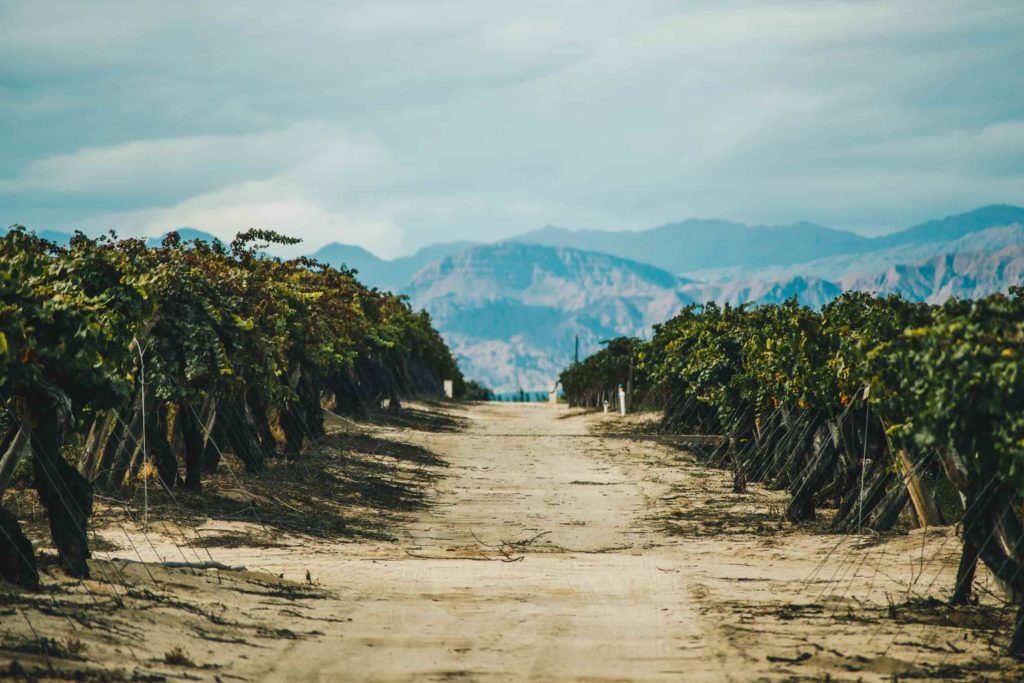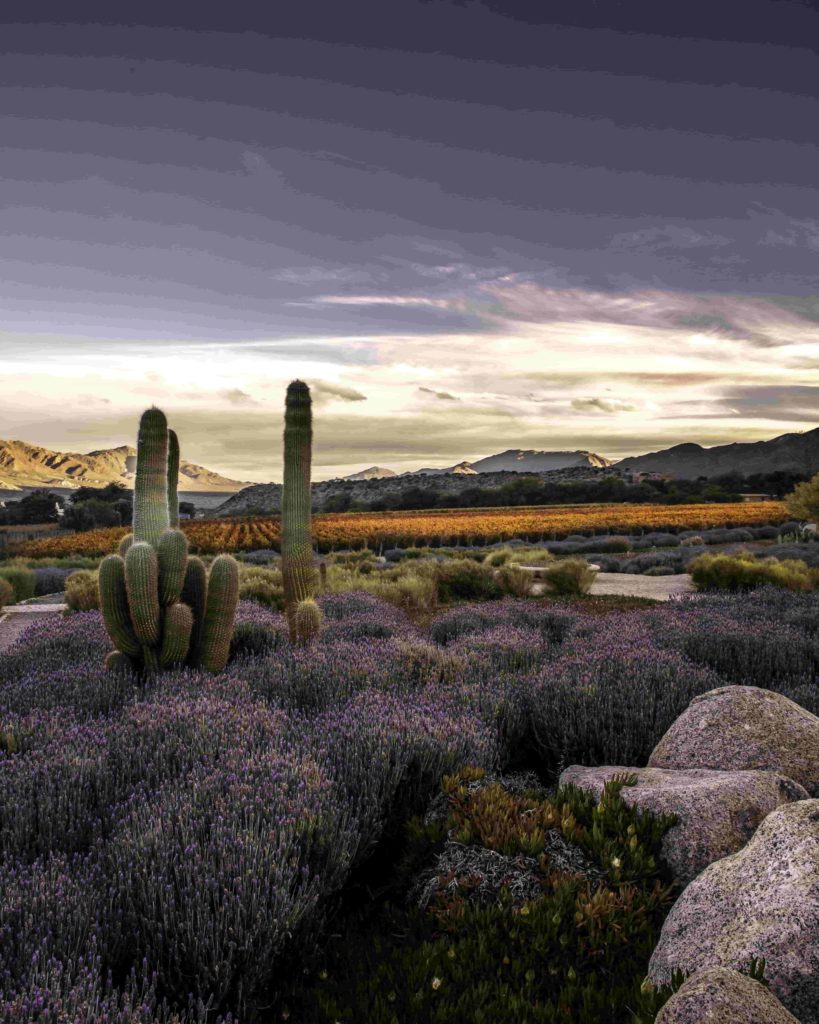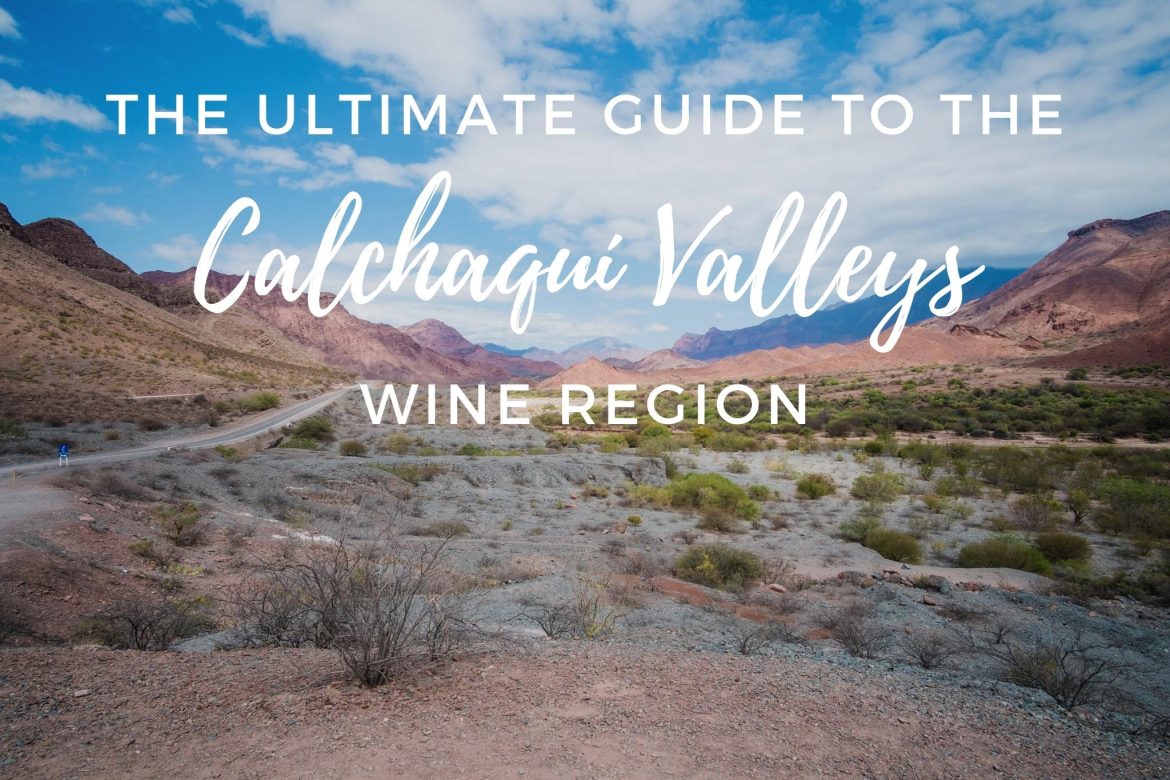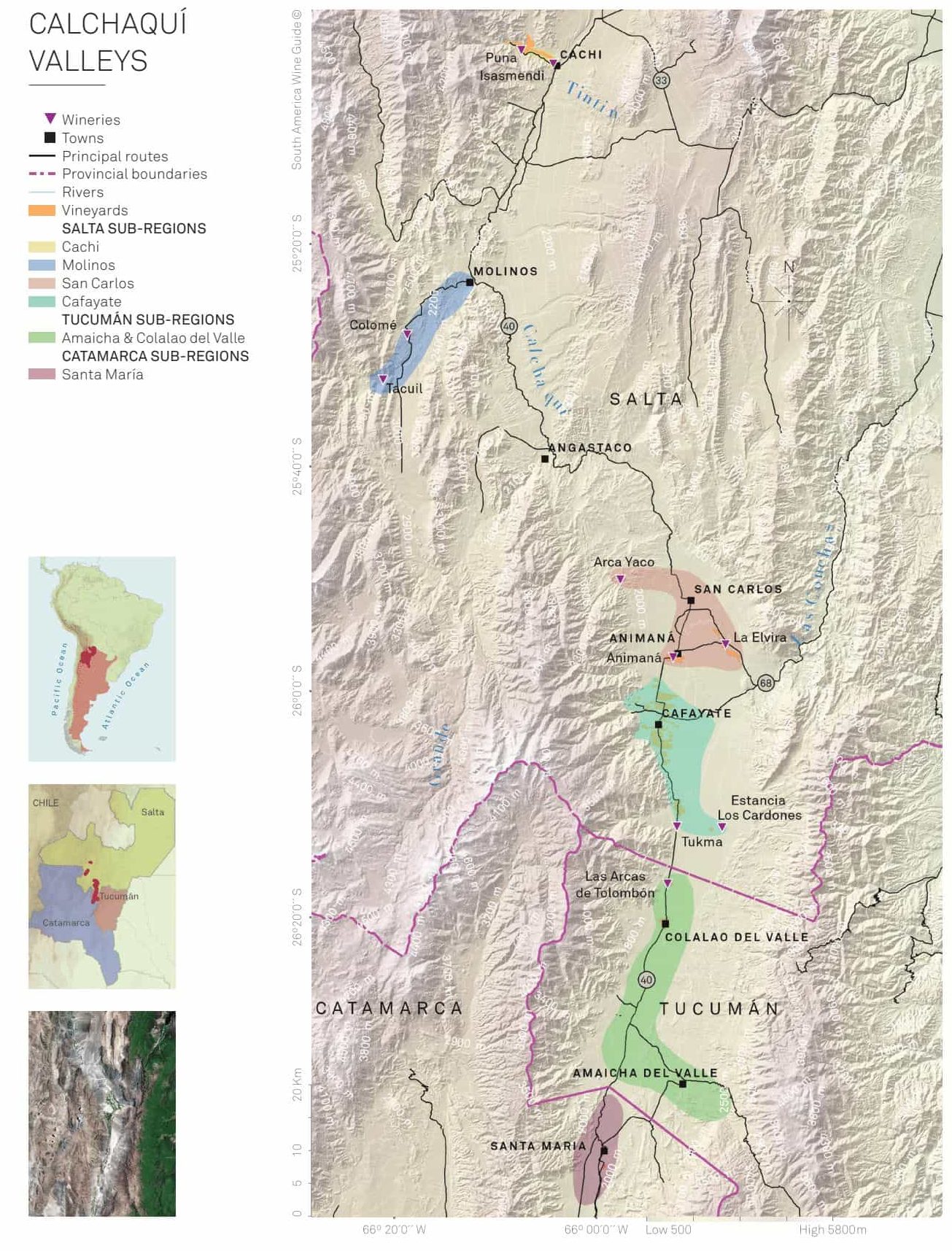In Northern Argentina the Calchaquí Valleys are one of the most distinctive wine regions of the country: known for intense sunlight, high altitude and powerful red and white wines (especially its world-famous Torrontés!) Find out all about the sub regions like Salta, Cafayate and Cachi in our ultimate guide to the wine region of Calchaquí!
Guide to Calchaquí Valleys wine region
Sub-regions of the Calchaquí Valleys
Notable Producers
Quick Guide to the Calchaquí Valleys
Best Wines to try
Map of the Calchaquí Valleys
Travel often feels surreal, but a trip to the Calchaquí Valleys can seem positively hallucinogenic! This is, indeed, one of Argentina’s most extraordinary wine regions…
Guide to the Calchaquí Valleys wine regions
First planted with vines in the middle of the 17th century, when Jesuit missionaries swept through the territories of Argentina, today the Calchaquí Valleys are the most important wine region in Northern Argentina, with over 4,200 hectares of vines. This is, in fact, the place that holds the record for having the oldest productive vines in Argentina, planted in 1862 and still producing Torrontés wine for Bodegas Etchart.
Old vines can be found throughout this string of mountain valleys which runs north to south, spanning over 270 km and three of Argentina’s provinces: Salta, Tucumán and Catamarca. The vineyards and wineries in the Calchaquí Valleys are surrounded by colourful mountains and mineral-rich hillsides in every direction. The brightly coloured hillsides with their kaleidoscopic hues of pink, purple, green and yellow are a tourist attraction in their own right, but also make the most striking background for vineyard visits.
In the same way that the pinstriped hills alternate between different coloured mineral deposits, the soils of the Calchaquí Valleys are just as varied. Pockets of pebbles, rocks and limestone can be discovered, often within the same vineyard, accompanied by well-draining, sandy-loam soils. Combine this poor soil with the incredibly dry weather, high altitude and the enormous thermal amplitude and you have a wine region that naturally produces low yields of healthy and concentrated grapes. The Calchaquí Valleys may only represent 2% of the country’s vineyards, but it claims a disproportionate share of Argentina’s wine awards — and with good reason, I say.

Sub-regions of the Calchaquí Valleys
SALTA
Hectares planted: 3,347
Sub-regions: Cafayate, Molinos, Cachi, San Carlos
Salta is just about the biggest wine-producing province in Northern Argentina but not by a wide margin (Catamarca only lags by 500 hectares), although it punches above its weight in terms of reputation. Salta, and in particular Cafayate, resonates with wine drinkers around the world largely because of its significant level of wine tourism and for being the mecca for Argentina’s best-known native white variety, Torrontés.
It’s not just because Salta is best-known for a white wine that it bucks the wine trend in Argentina; it also stands out because its wine production is growing! Salta is growing faster than any other of Argentina’s traditional wine regions, and its wines — both white and red — are becoming more widely appreciated worldwide. Over the last decade, plantings have increased by 50% and well over 1,000 hectares, many of them planted with Malbec and Cabernet Sauvignon.
Sub-regions of Salta
Cafayate
Hectares planted: 2,490
Cafayate is Salta’s biggest and most renowned wine region, and certainly the best-known and biggest in the Calchaquí Valleys too. Claiming over half of the vineyards in the Calchaquí Valleys, Cafayate is at the southern end of Salta province, right below the San Carlos sub-region, and about 100 km from the higher-altitude and northernmost Salta sub-regions of Molinos and Cachi.
Cafayate town is about 1,700 m.a.s.l. and its vineyards surround the town, some of them reaching altitudes in excess of 2,000 metres. There are many wineries and vineyards based in Cafayate and its wine tourism is booming, although the town itself is still quaint with a laid-back and authentic charm, making this a beautiful wine region to explore over a few days.
Click here to view our travel file to Cafayate: how to get around, where to eat & drink, and where to stay
Cachi
Hectares planted: 87
Cachi is the smallest of Salta’s wine regions but it is also the highest, with vineyards scaling up to 3,111 metres in altitude. Cachi is also the northernmost region in the Calchaquí Valleys — just above Molinos. There aren’t many wineries here but several vineyards produce grapes that are vinified elsewhere. This is an extreme-altitude terroir and I’m particularly fond of the mineral style of Sauvignon Blanc and structured Malbec from the region.
Molinos
Hectares planted: 130
The Molinos sub-region in Salta is just to the south of Cachi in the northernmost tip of the Calcahquí Valleys. The gravel, sand and volcanic soils, combined with the dry climate and high altitude give Molinos wines great concentration and character. A top terroir for both red and white varieties.
San Carlos
Hectares planted: 631
San Carlos is Salta’s second-largest sub-region and is just tucked to the north of Cafayate, but is a bit lower in altitude (only reaching 1,905 m.a.s.l.). It is also popular on the wine tourism route (being so close to Cafayate) and you’ll find boutique hotels and lots of artisan craft stalls in San Carlos.
TUCUMÁN
Hectares planted: 122
Sub-regions: Amaicha del Valle, Colalao del Valle
Tucumán is one of Argentina’s smallest provinces and its wine region is just as boutique, with 122 hectares planted to date. Although the Tucumán wine regions start just 30 km from Cafayate, the rise of viticulture here has been quite rapid and recent, considering that at the beginning of the 1990s there were barely a dozen hectares of vines planted.
The wine regions of Tucumán are within the Tafí del Valle region, which can be split into two sub-regions: Amaicha del Valle and Colalao del Valle. With just 30 km distance between them, Colalao del Valle sits just north of Amaiche del Valle and both wine regions straddle the Santa María river and run alongside the Calchaquí mountain range (its highest peak is just east of Amaicha del Valle, at 4,762 m.a.s.l.).
The vineyards here share very similar characteristics with those in Salta: generally high altitude (between 1,690 to 2,230 metres above sea-level), very low rainfall (just 100 mm per year) and wide thermal amplitude. Malbec is king (accounting for 40% of plantings), followed by Cabernet Sauvignon and Torrontés.
CATAMARCA
Hectares planted: 766
Sub-regions: Santa María
Catamarca as a province has over 2,800 hectares of vines planted; however, it is only the 760-odd hectares planted in the northern sub-region of Santa María that fall within the Calchaquí Valleys. Although Santa María only represents a quarter of Catamarca’s vineyards, it is the second-largest sub-region in the Calchaquí Valleys, after Cafayate.
Santa María as a wine region has also boomed significantly since the 90s, growing from 184 hectares in 1990 to 766 hectares in 2019. The increased interest in Santa María and this southernmost point of the Calchaquí Valleys has been largely driven by its excellent quality red wines (mainly Malbec and Cabernet Sauvignon) and its perfumed Torrontés.
Read about other wine regions in Argentina: Gualtallary, Los Chacayes, Paraje Altamira and Rio Negro
Notable producers in the Calchaquí Valleys
CAFAYATE
AMALAYA
Excellent value brand and winery in Cafayate, owned by the Hess Collection. Delicious white blend and juicy reds.
BODEGAS ETCHART
A leader in Cafayate and still producing great value, everyday wines with a particular focus on Torrontés.
AGUSTÍN LANÚS WINES
Boutique winery sourcing grapes from some of the most extreme-altitude terroirs around the Calchaquí Valleys, with a tasting room (Bad Brothers) in Cafayate proper.
EL ESTECO
This stunning colonial-style winery in the heart of Cafayate was founded in 1892 by French brothers David and Salvador Michel and steadily grew to become a well-known brand in Argentina. The Peñaflor Group purchased the historic estate in 2004, and it now has over 780 hectares of high-altitude vineyards between Cafayate and Catamarca. El Esteco is one of the most prolific producers in Northern Argentina with a diverse portfolio.
EL PORVENIR DE CAFAYATE
A beautifully restored historic family winery making modern and polished premium wines from Cafayate. A highlight on the wine route.
PIATELLI
The Piattelli family from the US have found two homes in Argentina — Cafayate and Mendoza. Smart, polished wines and top for tourism in Cafayate.
FINCA QUARA
Good value wines from this century-old family winery now in its fourth generation.
SAN PEDRO DE YACOCHUYA
One of the first premium wineries in Cafayate, this is a joint venture between the Etchart family and Bordeaux winemaker Michel Rolland. Powerful wines.
ESTANCIA LOS CARDONES
A modern winery with new vines making high-altitude wines under the expert hand of winemaker Alejandro Sejanovich.
MOLINOS
BODEGA TACUIL
The Dávalos family have owned this remote Molinos estate for over 200 years. Raúl Dávalos Sr. was a pioneer of premium unoaked wines, and the new generation is now adding some spin-off brands of their own.
COLOMÉ
Colomé was established in 1831 but was revamped in 2001 when the Hess family bought it and opened a hotel and museum in Molinos. Its most sky-scraping vineyard is at 3,111 m.a.s.l.
SAN CARLOS
ARCO YACO
Boutique winery by Matías Etchart, third generation of Salta’s famous Etchart wine family, in Quebrada de San Lucas at over 2,100 m.a.s.l. Powerful, distinctive reds.

Quick guide to the Calchaquí Valleys
Hectares planted
4,235 (Salta 3,347 ha; Tucumán 122 ha; Catamarca 766 ha)
Sub-regions in the Calchaquí Valleys
Salta: Cafayate, Cachi, Molinos, San Carlos; Tucumán: Amaicha del Valle, Colalao del Valle; Catamarca: Santa María
Soil type
Rocky, poor soils with a high proportion of sand
Most-planted varieties
Malbec, Cabernet Sauvignon, Torrontés, Tannat, Merlot, Cereza, Syrah, Bonarda, Moscatel
Terroir Selection: Wines to try from the Calchaquí Valleys
EL ESTECO, Chañar Punco
Santa María (Catamarca). $$$. Drinking window <20 years
This wild terrain was planted barely two decades ago but this Malbec-Cabernet Sauvignon blend has already developed irrepressible character. Bold notes of graphite, ash, dark berries and wild herbs. Intense but balanced with fine tannins and taut acidity. Age-worthy, energetic and probably Catamarca’s best.
EL PORVENIR DE CAFAYATE, Laborum de Parcela Torrontés Finca El Retiro
Cafayate (Salta). $$. Drinking window <10 years
One of the most elegant Torrontés wines I have ever tried: mineral, slightly spritzy and with delicate Asian pear, lychee, lime leaf and pea shoot aromas. El Porvenir always make enjoyable wine but Parcela, coming from 80-year-old vines in sandy-lime soil, is in a league of its own.
ESTANCIA LOS CARDONES, Tigerstone Malbec
Tolombón (Salta). $$. Drinking window <15 years
Winemaker Alejandro Sejanovich says this is the first Malbec to be harvested in Argentina each year (in February!), and the payoff is an exceptionally bright and fresh Malbec, filled with juicy red fruit, spice and an invigorating finish. From young vines on schist and mica soils.
COLOMÉ, Altura Máxima Lote Especial Sauvignon Blanc
Molinos (Salta). $$$. Drinking window <10 years
Salta and finesse don’t always go hand in hand, but this Sauvignon Blanc embodies the finesse, elegance and austerity you can get from the seriously high-altitude (3,111 metres!) vineyards. Delicate herbaceous and saline notes with electric acidity and a mouth-watering finish.
EL ESTECO, Old Vines 1947 Cabernet Sauvignon
Cafayate (Salta). $$. Drinking window <15 years
This old-vine, whole-bunch fermented Cabernet is wonderfully approachable in its youth with bright cassis and wild herb aromas. Juicy, spicy and peppery, the sort of Cab I’d love to tuck into while munching on spicy, Salteña empanadas.
SLA (SIERRA LIMA ALFA), Niño Gordo
Molinos (Salta). $$. Drinking window <5 years
SLA explores the wilder tastes of the Dávalos family. This perfumed, refreshing and grippy Criolla Chica comes from 80-year-old vines.
ARCA YACO, Amar y Vivir
San Carlos (Salta). $$. Drinking window <15 years
This inky and intense red blend of Malbec and Cabernet Sauvignon shows the wild intensity of the Calchaquí Valleys: peppery and meaty with black fruit at its core and a long, gravelly finish. Power and freshness from Quebrada de San Lucas.
PIATELLI, Torrontés
Cafayate (Salta). $. Drinking window <5 years
One of my ‘go to’ Torrontés wines in Argentina, this is modern and polished with attractive citrus and floral notes, balanced, refreshing acidity and a long finish. A classic.
EL PORVENIR DE CAFAYATE, Laborum de Parcela Finca Alto Río Seco Malbec
Cafayate (Salta). $$. Drinking window <10 years
From a special lot with a high percentage of limestone, this is a rather elegant and juicy Malbec from Cafayate. Filled with blue fruit and fresh forest berry aromas, it is a smooth and lively expression of Malbec with a deep colour and fine tannins.
PIATELLI, Malbec + Tannat
Cafayate (Salta). $$. Drinking window <10 years
Tannat is a variety that I think does particularly well in the heights of the Calchaquí Valleys, and this blend shows the great potential for making warming, full-bodied wines that still retain freshness. Inviting black fruit, charcuterie and spice notes.
Want to know more about the Calchaquí Valleys
and the wine regions of Argentina?
Get your copy of the ARGENTINA WINE GUIDE E-BOOK!
Map of the Calchaquí Valleys wine region
You can download all the wine region maps for South America for free on this link. Please feel free to share and use the wine region maps while crediting @SouthAmericaWineGuide.


